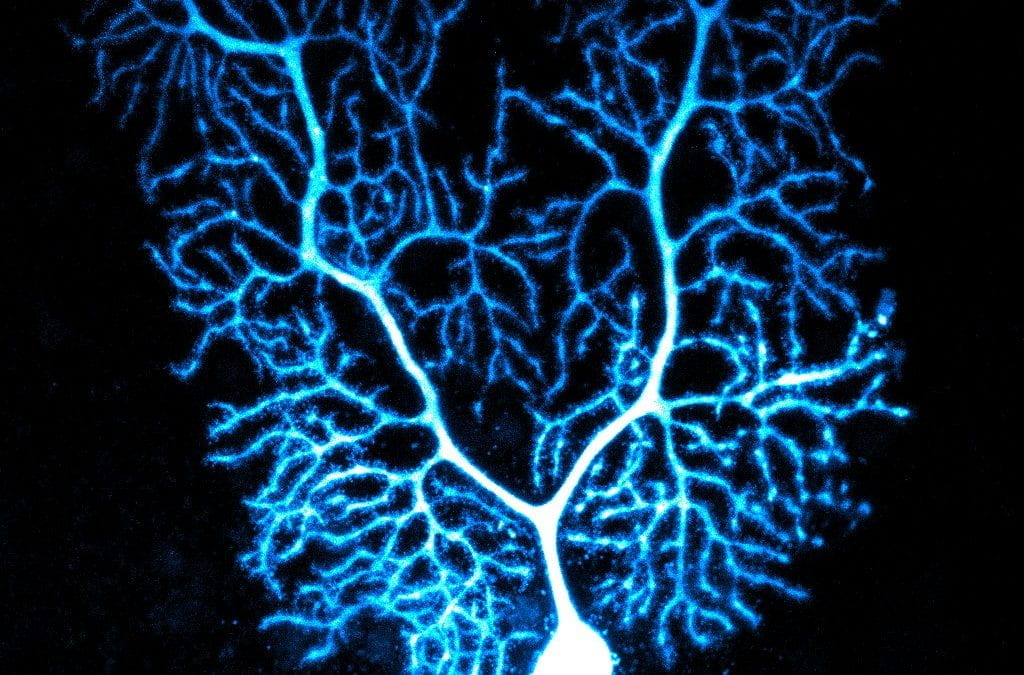New research at the University of Chicago has identified changes in neuronal circuits in the cerebellum that were linked to increased sensory-avoidant behavior in a mouse model of autism. The results, published online September 1 in Biological Psychiatry: Global Open Science, provide new insights into the role of the cerebellum in behavior and may help explain why some autistic individuals are more sensitive to certain sensory experiences.
The study was conducted using patDp/+ mice, a model for 15q11-13 duplication syndrome, one of the most common genetic causes of autism in humans. In addition to autism, 15q11-13 duplication syndrome is associated with delayed development and impairment of many motor skills, including sitting and walking.
The researchers focused on the cerebellum, a smaller, more wrinkled brain structure that is tucked underneath the back of the rest of the brain. Primarily thought of as a motor control center, recent studies in humans has found a role for the cerebellum in autism. In the current study, the researchers wanted to examine cerebellar circuits to determine if changes in neuronal signaling might play a role.
“Autism is difficult to study, because you’re interested in this brain condition that affects cognitive function and behavior in humans, but the human brain is mostly a black box because of our limited ability to access it,” said Christian Hansel, PhD, Professor of Neurobiology at UChicago. “You need to work with animal models, but those complex behaviors don’t usually translate well to mice. So in this study, we focused on a more basic question about motor learning, which might point the way toward other relevant behaviors.”
The study focused on the eyeblink response in mice exposed to sensory inputs such as a light flash, a burst of sound, or a puff of air. The researchers exposed mice to these multisensory stimuli while recording calcium signals from Purkinje cells, large, branching neurons found in the cerebellum. They found that patDp/+ mice had more cells responding to the stimuli and larger calcium signals compared to control mice, which corresponded to an increase in sensory-avoidant behaviors such as faster time to blinking and increased nose and ear movement.
On closer examination of the patDP/+ mice, the team determined there were stronger signals to the Purkinje neurons coming from climbing fibers, which originate in the brain stem. Importantly, the researchers also observed higher levels of a protein called neurexin 1 (Nrxn1) at the connections between the climbing fibers and Purkinje neurons. Nrxn1 is known to play a key role in synapse formation and maintenance, and increased expression of the protein at synapses could be contributing to the stronger signals.
In addition, the study found a decrease in the strength of signals coming from parallel fibers, the other main excitatory input connecting with Purkinje cells. “So, what we’re seeing is that the climbing fiber signaling is enhanced, and likely as a result, the parallel fiber signaling is weakened,” said co-author Silas Busch, a graduate student in the Hansel lab. “There’s a change in the balance of the two major excitatory inputs to the cerebellum, and that is linked with the increased calcium signaling we see, as well as the larger aversive responses to sensory input.”
These signaling changes were also connected with alterations in the cellular underpinnings of motor learning. Specifically, the researchers found that a phenomenon called long-term depression (LTD), which is an important component of how an animal learns to react to sensory stimuli, was reduced in the parallel fibers. However, using pharmacological interventions to artificially enhance the calcium signal in the Purkinje cells restored normal LTD.
“It’s like this pathway is promoting these error signals in the motor response,” said Hansel. “Typically, the climbing fibers are activated to make your body adapt to sensory motor information, like adjusting your position, but that signal is now being grossly inflated, and now there are issues with how the connectivity is being optimized — or not.”
Ultimately, the researchers say this work can help inform our understanding of both the role of the cerebellum in the brain generally as well as its role in autism.
“It’s not as simple as saying that the brain is divided up into individual areas that do a single thing; brain areas interact with each other to do different tasks,” said Busch. “The cerebellum doesn’t have a single role. It provides computations for a variety of different purposes. We’re studying a limited set of behaviors and circuit components, but these structures are used for multiple purposes, so understanding how these circuits can be disrupted and affect one kind of behavioral output can give us important clues about other kinds of behaviors.”
The team is eager to expand the work and hopes to begin studying living human brain tissue collected as a byproduct of brain surgery in autistic and control patients, tissue that would otherwise be designated as medical waste. The goal, they say, is to examine the same cerebellar circuitry and cortical networks in humans to see if there are similar changes in signaling and synaptic learning mechanisms, such as LTD. In the future, this may lead to opportunities for new therapeutics that could aid autistic patients experiencing sensory sensitivity.
The study, “Sensory over-responsivity and aberrant plasticity in cerebellar cortex in a mouse model of syndromic autism,” was supported by the Simons Foundation (SFARI 203507 and 311232), the Brain Research Foundation (BRF SG 2011-07), the National Institute of Neurological Disorders and Stroke (NINDS) (F31-NS095771), and the University of Chicago Biological Sciences Division. The study’s additional authors are Dana H. Simmons, Justine Shih, Xiofei Du, Cenfu Wei, Christopher M. Gomez and Claire Piochon of UChicago; Heather K. Titley of UChicago and the University of Alberta; and Giorgio Grasselli of UChicago, the Instituto Italiano di Tecnologia, and IRCC Osedale Policlinico San Martino.

